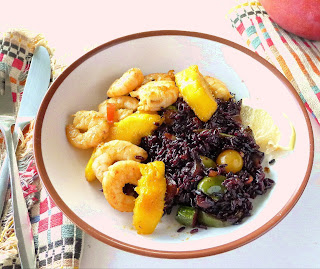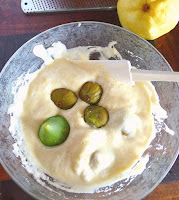I have a house rule—no turning on the oven from June till September. With the first day of fall and a somewhat cooler kitchen, I am so excited to roast a chicken again!
 |
| Burnished roast chicken, an autumnal pleasure. |
When my kids were growing up, roast chicken was a favorite easy, weeknight meal. While the boys were doing homework and baths, I would bung a whole, small chicken in the oven with nothing more than a scattering of thyme and chopped garlic, salt and pepper. In a little more than an hour, dinner was on the table.
Now, I seek out free-range chicken, much larger than those battery-raised supermarket birds. They’re much more expensive and take longer to roast, so chicken is a special dish.
The first day of fall also marks my switch from the chilled rosado (rosé wine) that I favour in torrid summer weather to tinto (red wine). As I select a robust Rioja crianza—a red wine from La Rioja with a little time on oak (this one is tempranillo with a little garnacha), I recall that the most famous dish of La Rioja was the one that didn’t get eaten--a roast chicken set before the town magistrate of Santo Domingo de la Calzada back in the 14th century.
The story goes that a youth who was traveling with his family on a pilgrimage to the holy shrine of Santiago stopped over at an inn in Santo Domingo and was framed by a scheming girl, possibly because he spurned her advances.
The girl placed a piece of silver in his rucksack, then falsely accused the boy of thievery. He was sentenced and hanged for the crime. But his parents heard his voice calling out from the gallows, saying he was still alive.
They rushed to tell the town magistrate, who was just sitting down to a dinner of roast chicken. He dismissed their claims, “Your son is as alive as this chicken that I am about to eat.” With that the chicken hopped from the plate and began clucking and strutting about. The boy, indeed, was still alive and was released. The saying goes, “Santo Domingo de la Calzada, que cantó la gallina despues de asada,” where “the chicken cackled after it was roasted.”
 |
| Dinner from the oven--roast chicken with chorizo and sweet potatoes. Pour some red Rioja wine to go with it. |
 |
| Chorizo sausage adds color and flavor to the chicken and pan sauce. |
And, now that I’ve turned on the oven, I might as well roast some sweet potatoes, the first of the season.
 |
| First of the season--locally-grown sweet potatoes. |
Roast Chicken with Chorizo
Pollo Asado con Chorizo
Pollo Asado con Chorizo
 |
| Roast chicken is juicy, basted with chorizo fat. |
Use chorizo link sausage, the slightly soft type that is best for grilling and stewing. (Dry-cured chorizo is best sliced as a cold-cut rather than used in cooking.) If chorizo is not available, use a spoonful of pimentón (paprika) mixed with olive oil for basting the chicken.
The pan drippings with chorizo fat are good spooned over potatoes or other vegetables.
The pan drippings with chorizo fat are good spooned over potatoes or other vegetables.
 |
| Herbs, garlic and chorizo are stuffed in the bird's cavity. On the left are dried choricero peppers, used to flavor chorizo. |
Salt
Freshly-ground black pepper
Bay leaves
Thyme sprigs
Rosemary sprig
Lemon slice
3 cloves garlic, lightly crushed
3 chorizo sausages (7 ounces)
1 tablespoon olive oil
½ cup white wine
Sprinkle the chicken inside and out with salt and pepper. Allow to stand 30 minutes.
Tie the bay leaves, thyme and rosemary into a bouquet and insert in the chicken’s cavity with the lemon slice and (unpeeled) garlic.
Slice the chorizo. Heat oil in a small skillet and fry the chorizo, turning to brown both sides. Tilt the pan and skim out the chorizo. Save the fat in the pan.
Preheat oven to 425ºF.
 |
| Use chorizo pan drippings to baste the chicken. |
Baste the chicken with pan drippings. Lower oven temperature to 350ºF. Roast 30 minutes more.
Baste the chicken again with pan drippings. Pour over the wine. Roast chicken 30 minutes more or until juices run clear.
Remove chicken to a platter or cutting board and allow to rest 15 minutes before carving. Discard the bunch of herbs. Place the chorizo on serving platter with the chicken. Peel the garlic cloves and use them as garnish. Serve the pan juices in a separate bowl.
More recipes for roast chicken:
Lemon-roasted chicken.
Roast stuffed chicken.
and, for Potatoes, La Rioja Style (with chorizo) http://mykitcheninspain.blogspot.com.es/2010/04/potatoes-from-canary-islands-to-la.html



























